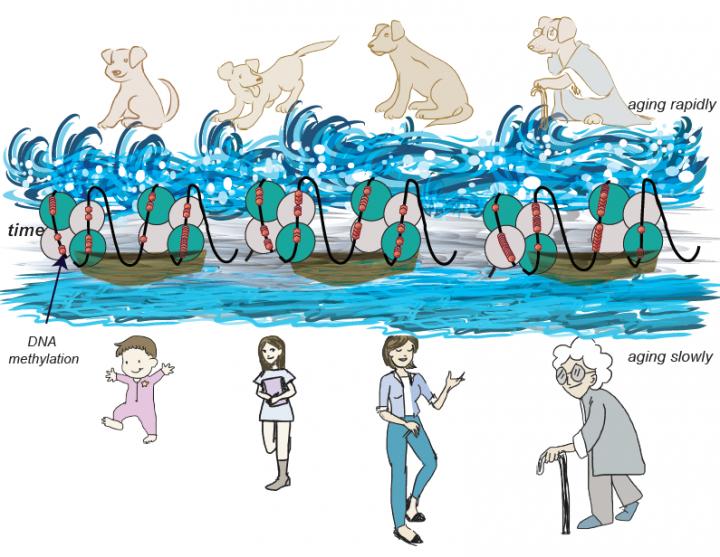
Credit: Ideker Lab, UC San Diego
How old is your tail-wagging bundle of joy in human years? According to the well-known “rule of paw,” one dog year is the equivalent of 7 years. Now, in a study published July 2, in the journal Cell Systems, scientists say it’s wrong. Dogs are much older than we think, and researchers devised a more accurate formula to calculate a dog’s age based on the chemical changes in the DNA as organisms grow old.
Dogs share the same environment as their owners and receive almost the same standard of health care as humans, providing a unique opportunity for scientists to understand aging across species. Like humans, dogs follow similar developmental trajectories that lead them to grey and become more susceptible to age-related diseases over time. However, how they age on a molecular level is more complicated–aging rapidly at first and slowing down later in life.
“In terms of how physiologically mature a 1-year-old dog is, a 9-month-old dog can have puppies. Right away, you know that if you do the math, you don’t just times seven,” says senior author Trey Ideker (@TreyIdeker) of the University of California, San Diego. “What’s surprising is exactly how old that one-year-old dog is–it’s like a 30-year old human.”
Human and dog DNA, which codes who we are, doesn’t change much throughout the course of life, but chemical marks on the DNA, called methylation marks, do. Ideker considers these marks like wrinkles in the genome. “I tend to think of it very much like when you look at someone’s face and guess their age based on their wrinkles, gray hair, and other features,” he says. “These are just similar kinds of features on the molecular level.”
The researchers studied 104 Labrador retrievers spanning from few-week-old puppies to 16-year-old dogs with the help of two canine experts, Danika Bannasch of the University of California, Davis, and Elaine Ostrander of the National Institutes of Health. They compared the changes in the methylation pattern to humans.
The comparison revealed a new formula that better matches the canine-human life stages: human age = 16 ln(dog age) + 31. Based on the new function, an 8-week-old dog is approximately the age of a 9-month-old baby, both being in the infant stage where puppies and babies develop teeth. The average 12-year lifespan of Labrador retrievers also corresponds to the worldwide life expectancy of humans, 70 years.
“I like to take my dogs on runs, and so I’m a little bit more sympathetic to the 6-year-old now,” says Ideker, who realized that his dog is pushing 60 according to the new calculation.
In both species, they found that the age-driven methylation largely happens in developmental genes that are hotly fired up to create body plans in utero and regulating childhood development. By the time one becomes an adult and stops growing, “you’ve largely shut off these genes, but they’re still smoldering,” says Ideker. “If you look at the methylation marks on those developmental genes, they’re still changing.”
Focusing on the smoldering developmental genes, the team developed a clock that can measure age and physiological states across different species, while other methylation-quantifying age-predicting methods only do well in one species. Ideker also noted that future investigation in different dog breeds with various lifespans could provide more insight into the new clock. The clock may not only serve as a tool to understand cross-species aging but also apply as clinical practice for veterinarians to take proactive steps to treat animals.
###
This work is supported by the following: the California Institute for Regenerative Medicine, the National Institute for Environmental Health Sciences, the National Institute of General Medical Sciences, the National Institute on Aging, the National Institute of Dental and Craniofacial Research, the Maxine Adler Endowed Chair Funds, and the Intramural Program of the National Human Genome Research Institute.
Cell Systems, Wang et al.: “Quantitative Translation of Dog-to-Human Aging by Conserved Remodeling of the DNA Methylome”
https://www.cell.com/cell-systems/fulltext/S2405-4712(20)30203-9
Cell Systems (@CellSystemsCP) is a monthly journal published by Cell Press devoted to systems biology. Cell Systems papers use approaches from physics, engineering, mathematics, and computer science to address salient biological questions. Visit: http://www.
Media Contact
Carly Britton
[email protected]
Related Journal Article
http://dx.




